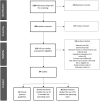The use of video laryngoscopy outside the operating room: A systematic review
- PMID: 36264980
- PMCID: PMC9584394
- DOI: 10.1371/journal.pone.0276420
The use of video laryngoscopy outside the operating room: A systematic review
Abstract
This study aimed to describe how video laryngoscopy is used outside the operating room within the hospital setting. Specifically, we aimed to summarise the evidence for the use of video laryngoscopy outside the operating room, and detail how it appears in current clinical practice guidelines. A literature search was conducted across two databases (MEDLINE and Embase), and all articles underwent screening for relevance to our aims and pre-determined exclusion criteria. Our results include 14 clinical practice guidelines, 12 interventional studies, 38 observational studies. Our results show that video laryngoscopy is likely to improve glottic view and decrease the incidence of oesophageal intubations; however, it remains unclear as to how this contributes to first-pass success, overall intubation success and clinical outcomes such as mortality outside the operating room. Furthermore, our results indicate that the appearance of video laryngoscopy in clinical practice guidelines has increased in recent years, and particularly through the COVID-19 pandemic. Current COVID-19 airway management guidelines unanimously introduce video laryngoscopy as a first-line (rather than rescue) device.
Conflict of interest statement
The authors have declared that no competing interests exist.
Figures
References
-
- Russotto V, Myatra SN, Laffey JG, Tassistro E, Antolini L, Bauer P, et al.. Intubation Practices and Adverse Peri-intubation Events in Critically Ill Patients from 29 Countries. JAMA—Journal of the American Medical Association. 2021. Mar 23;325(12):1164–72. doi: 10.1001/jama.2021.1727 - DOI - PMC - PubMed
-
- Cook TM, Woodall N, Harper J, Benger J. Major complications of airway management in the UK: Results of the Fourth National Audit Project of the Royal College of Anaesthetists and the Difficult Airway Society. Part 2: Intensive care and emergency departments. Br J Anaesth. 2011;106(5):632–42. doi: 10.1093/bja/aer059 - DOI - PubMed
-
- Edelman DA, Perkins EJ, Brewster DJ. Difficult airway management algorithms: a directed review. Vol. 74, Anaesthesia. Blackwell Publishing Ltd; 2019. p. 1175–85. - PubMed
Publication types
MeSH terms
LinkOut - more resources
Full Text Sources
Medical


